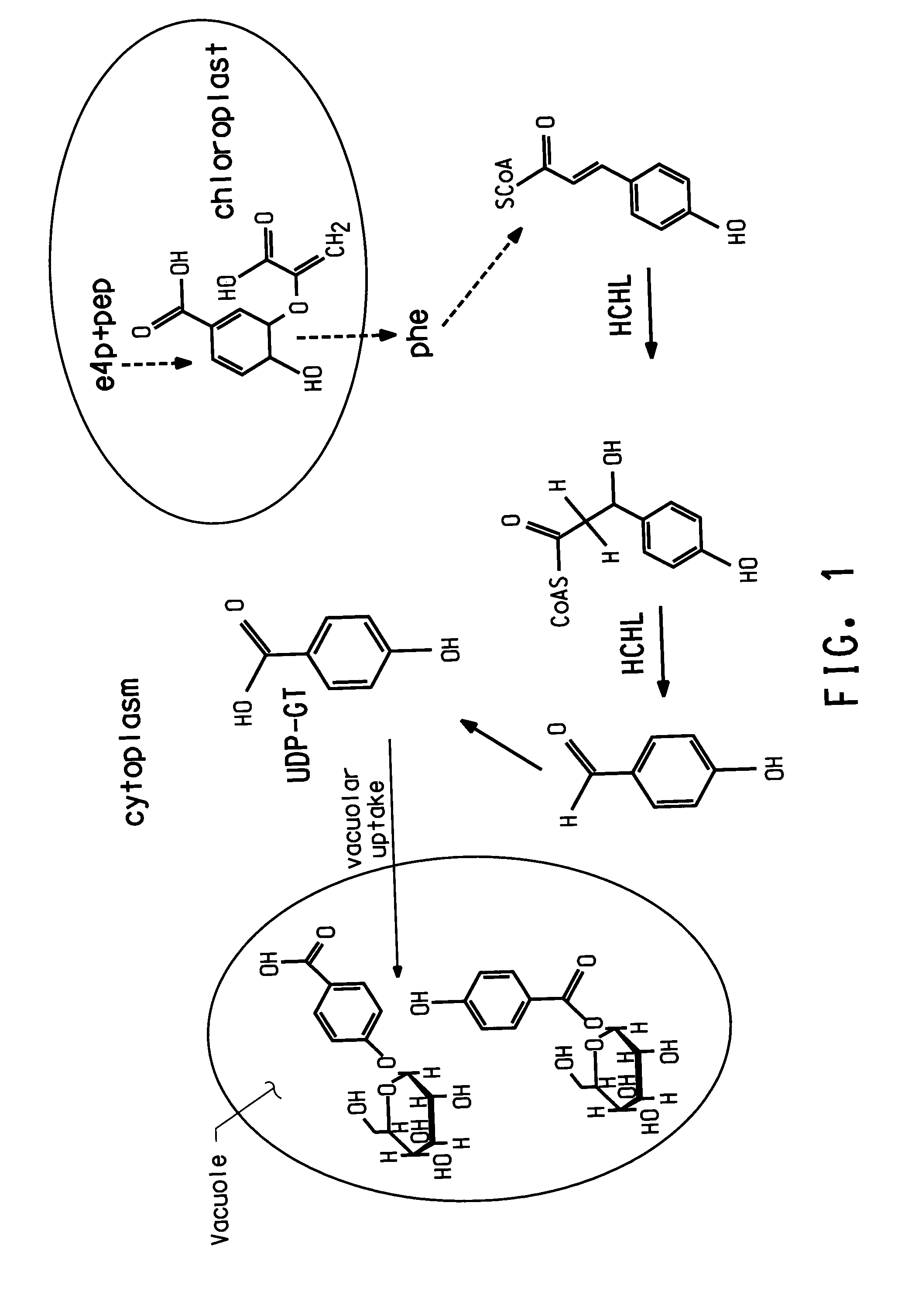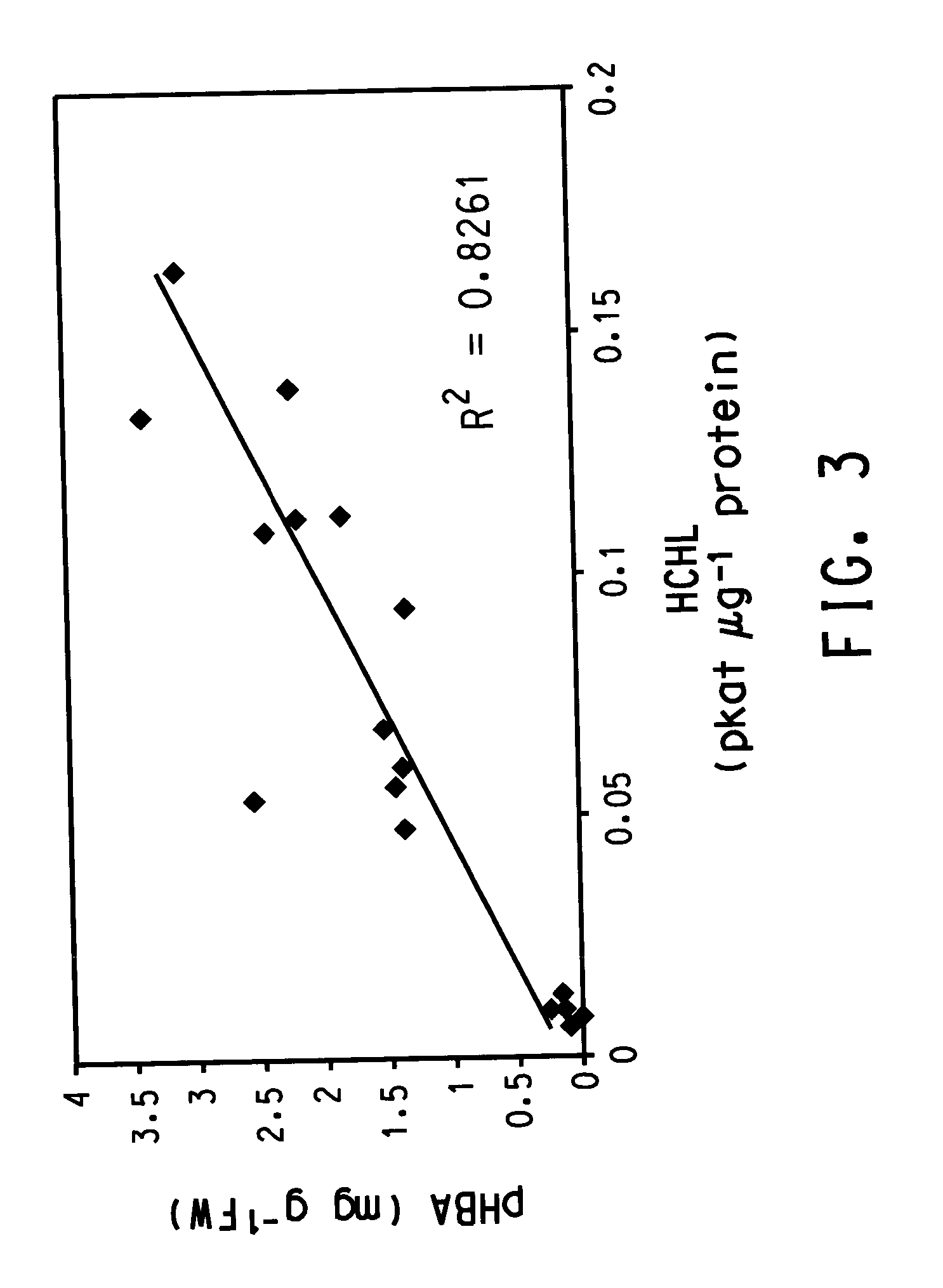Method to produce para-hydroxybenzoic acid in the stem tissue of green plants by using a tissue-specific promoter
a technology of para-hydroxybenzoic acid and stem tissue, applied in the field of plant gene expression, molecular biology, microbiology, can solve the problems high cost, and limited size of plants, and achieve the effects of low pollen production, low cost, and high cos
- Summary
- Abstract
- Description
- Claims
- Application Information
AI Technical Summary
Benefits of technology
Problems solved by technology
Method used
Image
Examples
example 1
Cloning and Characterization of an HCHL Gene from Pseudomonas putida (DSM 12585)
[0231] Evaluation of HCHL-mediated pHBA production in Arabidopsis focused on the HCHL gene from Pseudomonas putida (DSM 12585). Muheim and Lerch (Appl Microbiol Biotechnol, 51:456-461(1999)) reported that this strain was able to convert ferulic acid to vanillin and several studies have reported the cloning of an HCHL gene from closely related Pseudomonas strains encoding the HCHL enzyme that is responsible for this activity. The Pseudomonas strain described by Muheim and Lerch (supra) was ordered from the DSM (Deutsche Sammlung von Microorganismen und Zelkulturen, Braunschweig, Germany). The strain was able to grow on minimal media (Miller, J;Experiments in Molecular Genetics, 1972, Cold Spring Harbour Laboratory Press) containing 1-10 mM pHCA as sole carbon source providing strong support for the presence of an HCHL enzyme in this organism. Genomic DNA was isolated from this strain using standard metho...
example 2
Plant Expression of the HCHL Gene of Pseudomonas putida (DSM 12585) Under the Control of Constitutive Promoters
Construction of Binary Vectors
[0238] For constitutive expression of the Pseudomonas putida (DSM 12585) HCHL enzyme in plants, two binary vectors were generated. In one construct, the HCHL gene was under the control of the promoter of the ACTIN2 gene from Arabidopsis. It had been shown previously that this promoter confers a constitutive pattern of reporter gene expression in plants (An et al., Plant Journal, 10(1): 107-121 (1996)). In the other construct, the HCHL coding sequence was fused to the CaMV35S promoter.
[0239] Genomic DNA from Arabidopsis thaliana plants and two PCR primers used to amplify a 1220 bp fragment of the ACTIN2 gene that comprised promoter region and 5′UTR of the gene: Primer 8 CMCTATTTTTATGTATGCAAGAGTCAGC (SEQ ID NO:11) and Primer 9 CCATGGTTTATGAGCTGCAAACACAC (SEQ ID NO:12). The sequence of the ACTIN2 promoter (“ACT2”) fragment is set forth as SEQ ...
example 3
Stalk-Specific Expression of HCHL in Plants
[0251] In this Example, the utility of different stalk-specific promoters was determined. A pattern of HCHL expression that targeted the specialized cell types having a high rate of pHCACoA synthesis would produce a high level of pHBA in the stalk. Lignin biosynthesis is a cell autonomous process. RNA blot experiments, expression of reporter gene constructs, and immunolocalization studies of enzymes of the phenylpropanoid pathway suggest that the bulk of monolignols is produced in the cells that undergo lignification. There is only a limited transfer of monolignols from neighboring xylem or ray parenchyma cells to tracheids or vessel elements (presumably at later stages of cell differentiation) to sustain lignification after the water-conducting cells have undergone autolysis. The promoters of genes closely related to the synthesis of (or consumption of) pHCACoA in lignin biosynthesis were selected in order to target HCHL expression to pla...
PUM
| Property | Measurement | Unit |
|---|---|---|
| molecular weight | aaaaa | aaaaa |
| pH | aaaaa | aaaaa |
| pH | aaaaa | aaaaa |
Abstract
Description
Claims
Application Information
 Login to View More
Login to View More - R&D
- Intellectual Property
- Life Sciences
- Materials
- Tech Scout
- Unparalleled Data Quality
- Higher Quality Content
- 60% Fewer Hallucinations
Browse by: Latest US Patents, China's latest patents, Technical Efficacy Thesaurus, Application Domain, Technology Topic, Popular Technical Reports.
© 2025 PatSnap. All rights reserved.Legal|Privacy policy|Modern Slavery Act Transparency Statement|Sitemap|About US| Contact US: help@patsnap.com



